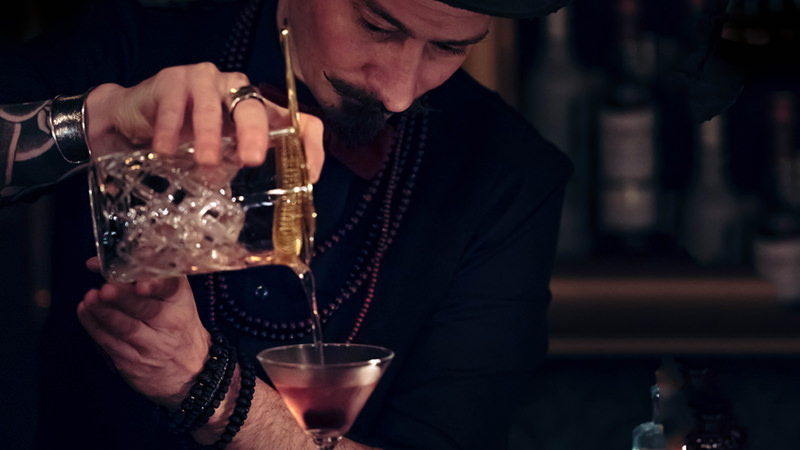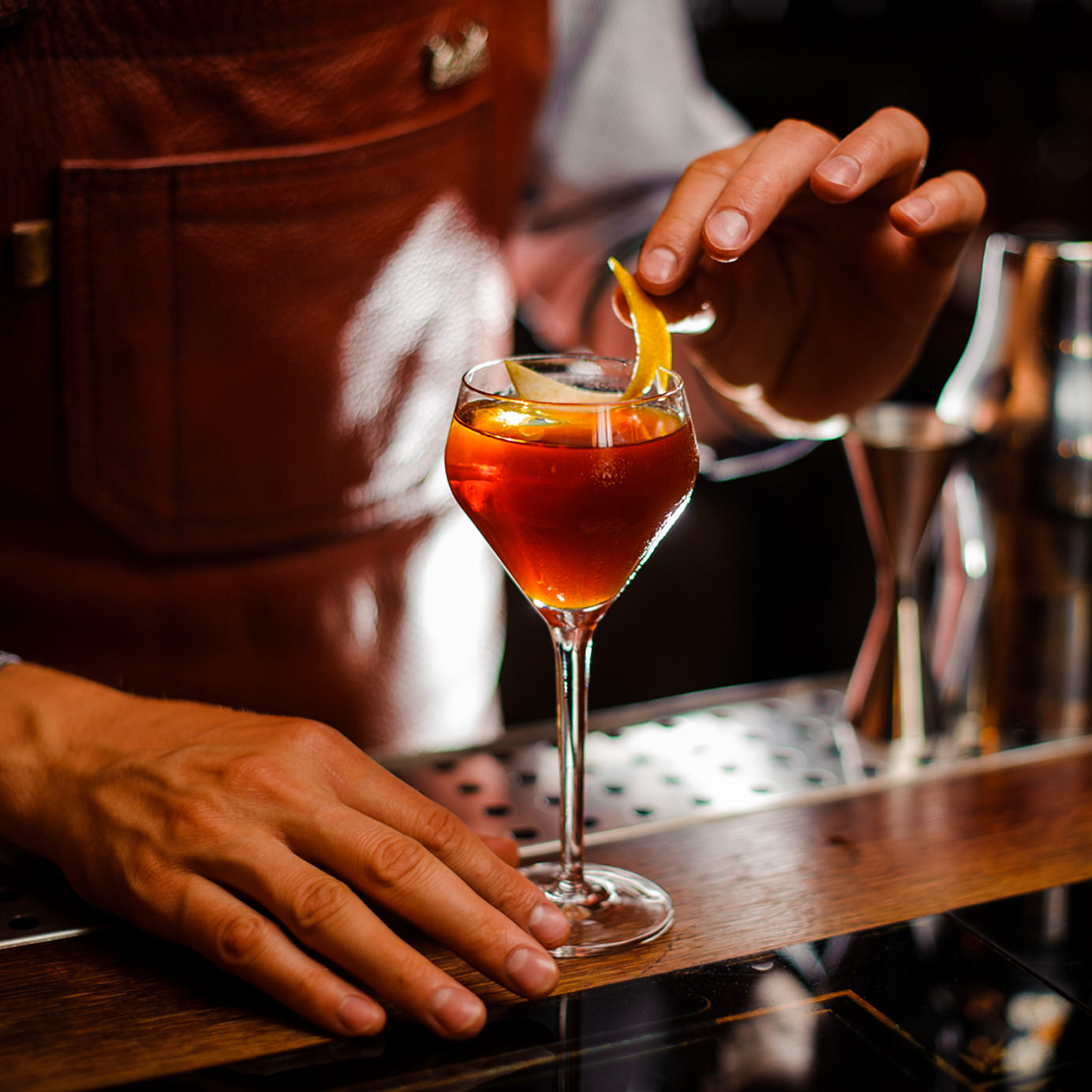Have you ever pulled up a stool at your favorite bar to order your favorite cocktail, from your favorite bartender, who makes it just the way you like it, only to find they’ve left for a new job? We’ve all been there. As disappointing as it can be, there used to be a pretty good chance of that beloved person popping up at some other reputable establishment. You might start going there instead; and, soon enough, the cycle repeats itself.
Now there’s a new gig drawing the world’s best and brightest bartenders like moths to the moon. It’s called brand ambassadorship, and it’s unstoppable.
For those unfamiliar, in the drinks world, a brand ambassador is someone hired to represent a particular spirit or collection of spirits to buyers and consumers. Each brand has different expectations for its ambassadors, and each ambassador brings different talents to the table. In a modern sense, the role has been around for less than 20 years but, in that short time, sales and brand awareness are way up. The gig is here to stay.
It’s easy to dismiss brand ambassadors as the death of bartenders, or the noble craft of bartending. It’s also easy to get lost in the glamour of all-expense-paid trips to cutting-edge cocktail bars and emerging nightlife destinations around the world. In reality, the rise of spirits brand ambassadorship is the natural and necessary result of a growing, globalized marketplace where relationships are paramount.
The cocktail industry has become just that — an industry. Gone are the days when running a nice bar was enough. Now there are global trends to push or participate in, and worldwide communities driving the craft forward at unprecedented speed.
The first brand ambassador was probably John G. Martin, a 1940s liquor executive. His Russian-built Smirnoff Vodka was almost unknown in the U.S. at that time. As the story goes, Martin bought a newly invented Polaroid camera and drove from bar to bar taking pictures of bartenders holding a bottle of Smirnoff in one hand and a Moscow Mule in the other. In doing so, Martin invented not only a delicious drink, but also an ingenious marketing strategy. Smirnoff and the Moscow Mule were cemented in history, thanks to what modern-day corporate consultants would call “partnership marketing” and “in-store activations.”
Most people in the beverage industry now see ambassadorship as a coveted position. Representing a cool spirits company means leading trips around the world, bringing bartenders “to the source” of your product, sharing stories of recipes reborn from lost scraps of paper found in dusty corners of distilleries, and swiping corporate cards at cocktail hours to ensure that everyone has the time of their lives on behalf of your brand.
The appeal is obvious. Ordinarily, a trip to, say, a Caribbean island, with the express purpose of consuming rum and touring distilleries, would cost hundreds or even thousands of dollars for an individual. Brand ambassadors, however, don’t have to touch their personal bank accounts. For some, a corporate card becomes the rich parents a kid never had.
Colin Asare-Appiah, senior portfolio ambassador for Bacardi in the U.S. and voted “Best American Brand Ambassador” at the 2016 Tales of the Cocktail, cautions that the perception of brand ambassadorship people get from social media and word of mouth can be misleading.
“They don’t see the early morning wake-ups after late nights to deliver in-depth trainings, to turn around and fly somewhere else,” Asare-Appiah says. “You’re away from your family a lot and it can put a strain on your relationships. People enroll themselves and then they quickly realize it’s not for them.”
A good ambassador is always switched on, ready to represent their brand with pride and graciousness. But they also have to be incredibly budget-conscious, socially aware, responsible, and ready to spend a huge part of their lives on airplanes and in hotels.
“We’re there to educate, engage, and entertain,” Asare-Appiah says. Though, one might add, not always in that order.
“When I first started, it was much more about education,” Simon Ford, one of the most highly respected ambassadors in the game, says. “We were a catalyst for exchanging ideas around the world. One of my proudest achievements was to be able to introduce New York bartenders to London bartenders.”
Simon, and others like him, created a global bartending community through which international bartenders could exchange techniques, develop trends, and build relationships. The abundance of ambitious bars and bartenders around the world would not be nearly as developed as they are currently were it not for him.
Now the world’s biggest brands have massive networks of brand ambassadors. (Pernod Ricard, for example, employs over 50 in the U.S. alone.) As a result, someone running an ambitious bar in Cape Town can get a direct line to the best bartenders in London through a highly communicative daisy chain of brand ambassadors. This worldwide game of telephone for creative exchange means new and interesting bars and cocktail lists at a rate accelerated far beyond innovation limited by geography and immediate social networks.
These days, Ford says, ambassador roles are “much more about looking out for your friends and tapping into networks. Education is much less important than it used to be, and that’s a little sad in a way.”
That said, Ford thinks the de-emphasis of education also speaks to the maturity of the industry. “Since every bartender in the world already knows what Campari is, it is now much more their role to build loyalty to the brand through creating experiences and loyalty through social media, etc.,” he says.

Brand ambassadors are also able to mentor the next generation of bartenders in unprecedented ways. Asare-Appiah hosts an annual event called “Letters to a Young Bartender,” where bar professionals essentially speak to their professionally fledgling selves.
“Some really impactful stuff comes up,” he says. “Self-reflecting and learning from it is really important, asking myself, would I want to be spoken to that way, would I want to be treated that way?”
In a world of rapidly expanding beverage categories, with more products available than ever, brand owners are looking for every creative edge possible to set theirs apart. Despite the boom in demand for people to satisfy this position, Ford worries that modern brand ambassadors are being looked at as a part of a corporate strategy, as opposed to an individual asset to be cultivated.
“Back when I was at Pernod, I was initially the only brand ambassador, and when I left, there were 55,” Ford says. This is either a boom or a bubble, and all bubbles inevitably pop.
Even with a great product and a fleet of excellent ambassadors, the market is fickle. If brands commodify their ambassadors, instead of investing in them as long term partners, those representatives will be the first to go when budgets tighten or sales slump.
“I’m the owner of a brand that is losing money, and I can’t make money if I’m only selling to cocktail bars,” Ford adds. “We’re 100 percent based on a brand ambassador model, and we’re in the absolute best bars in the world, but until I get into the general consumer space, we won’t sustain. I had this idealistic dream that I would be able to sustain with only the cocktail bars, but unfortunately, lots of different brands had the same idea.”
Experienced brand ambassadors are now making moves to safeguard their careers. They are establishing their own companies, as Simon did, or transitioning into marketing positions in larger companies.
“Soon, we’ll see the next stage and more advanced, tailored marketing teams will be created,” Asare-Appiah says.
Justine Roux worked as a brand ambassador for two years before joining the staff of U.K.-based Seedlip Drinks. “Though now I’m technically a market manager, we use the title interchangeably with ambassador,” she says.
When ambassadors are talented enough to ably represent their brand in regional, national, or global markets, they have considerably more leverage with their employers. If they want to alter their position within the company, they might be able to move in-house and train a new ambassador, all while retaining their “halo accounts,” or the most prestigious bars and restaurants that are most important to support.
This ability to move vertically and laterally within an organization while still maintaining the connections that lead to success as an ambassador is what Roux thinks is “really cool about this industry. I feel like you can really grow up into this role, in a lot of different directions,” she says.
It also speaks to the ways the industry is diversifying. The most enviable positions in the spirits community were once held exclusively by a tight-knit group of skilled, front-running bartenders and distillers. As increased interest, education, and experience raise the collective bar, the number of ambitious professionals and opportunities in this industry grows.
The very existence of brand ambassadors demonstrates just how far we’ve come. Our future is bright, and much bigger than before.
